Blog
Leonard Joseph Tristano (March 19, 1919 – November 18, 1978) was an American jazz pianist, composer, arranger, and teacher of jazz improvisation.
Tristano studied for bachelor’s and master’s degrees in music in Chicago before moving to New York City in 1946. He played with leading bebopmusicians and formed his own small bands, which soon displayed some of his early interests – contrapuntal interaction of instruments, harmonic flexibility, and rhythmic complexity. His quintet in 1949 recorded the first free group improvisations. Tristano’s innovations continued in 1951, with the first overdubbed, improvised jazz recordings, and two years later, when he recorded an atonal improvised solo piano piece that was based on the development of motifs rather than on harmonies. He developed further via polyrhythms and chromaticism into the 1960s, but was infrequently recorded.
Tristano started teaching music, especially improvisation, in the early 1940s, and by the mid-1950s was concentrating on teaching in preference to performing. He taught in a structured and disciplined manner, which was unusual in jazz education when he began. His educational role over three decades meant that he exerted an influence on jazz through his students, including saxophonists Lee Konitz and Warne Marsh.
Musicians and critics vary in their appraisal of Tristano as a musician. Some describe his playing as cold and suggest that his innovations had little impact; others state that he was a bridge between bebop and later, freer forms of jazz, and assert that he is less appreciated than he should be because commentators found him hard to categorize and because he chose not to commercialize. Tristano was born in Chicago on March 19, 1919. His mother, Rose Tristano (née Malano), was also born in Chicago. His father, Michael Joseph Tristano, was born in Italy and moved to the United States as a child.
https://www.youtube.com/watch?v=D31_XJEHpV8
more...Lavere “Buster” Harding (March 19, 1917 – November 14, 1965) was a Canadian-born American jazz pianist, composer and arranger. Born to Benjamin “Ben” and Ada (née Shreve) Harding in North Buxton, Ontario,[1][3] Harding was raised in Cleveland, Ohio, where as a teenager he started on his own band. In 1939 Harding went to work for the Teddy Wilson big band, and then in the early 1940s went to work for the Coleman Hawkins band, and then Cab Calloway. He became a freelance arranger and worked with Benny Goodman, Artie Shaw, Roy Eldridge, Dizzy Gillespie, and Count Basie, among others. In 1949 he was the musical director for Billie Holiday recording sessions. In the early 1960s Harding played with Jonah Jones, though he was known primarily as an arranger and composer.Harding did not record as a leader. He died on November 14, 1965, in New York City.
more...Dillon “Curley” Russell (19 March 1917 – 3 July 1986) was an American jazz musician who played bass on many bebop recordings. A member of the Tadd Dameron Sextet, in his heyday he was in demand for his ability to play at the rapid tempos typical of bebop, and appears on several key recordings of the period. He left the music business in the late 1950s. On May 1, 1951 Russell played in the recording session for Un Poco Loco, composed by American jazz pianist Bud Powell, with Max Roach on drums. Literary critic Harold Bloom included this performance on his short list of the greatest works of twentieth-century American art. According to jazz historian Phil Schaap, the classic bebop tune “Donna Lee“, a contrafact on “Back Home Again in Indiana“, was named after Curley’s daughter. In 2002, she donated her father’s bass to the Institute of Jazz Studies at Rutgers University.
more...Purifying Our Homes
Extracts of red cedar have been shown to have antibacterial properties against common bacteria. Compounds with antifungal properties have also been isolated. Preparations:Most preparations of red cedar call for boiling the medicinal parts to make a decoction or for making a tea or infusion.
Internal uses include: boiling limbs to make a tuberculosis treatment, chewing leaf buds for sore lungs, boiling leaves to make a cough remedy, making a decoction of leaves to treat colds, chewing leaf buds to relieve toothache pain, making an infusion to treat stomach pain and diarrhea, chewing the inner bark of a small tree to bring about delayed menstruation, making a bark infusion to treat kidney complaints, making an infusion of the seeds to treat fever using a weak infusion internally to treat rheumatism and arthritis.
Medicinal uses: collect in summer/fall from young trees—highest oil content, antifungal, antibacterial—stimulates phagocytosis, helps athlete’s foot, ringworm, jock itch, nail fungus, chronic vaginitis, stimulates smooth muscle—helps with respiratory, urinary tract, and reproductive system problems, can make tea, tincture, cold infusion, steam.

Smudging my House with Sage brought from the Black Hills. Beliefs that burning sage clears out spiritual impurities, pathogens, and insects have been fundamental to the practice of smudging; it is also antimicrobial. We must purify our environments immediately! Call on every conceivable/viable process/force to eradicate this virus! And Pray, Meditate and Surround ourselves with Light! Together we are a IMPENETRABLE FORCE! We Will Survive!

more...
The Orion Bar stands out as a bright ridge to the Southeast of the Trapezium cluster, but its prominence is actually a consequence of limb brightening, i.e. our peculiar viewing angle. The Orion Nebula is bounded on multiple sides by an ionization front, but we happen to see the bar edge-on, causing it to appear brighter. Molecular hydrogen (H2) makes up 99% of the cold dense gas in galaxies. So mapping where stars are born basically means measuring H2, which lacks a strong characteristic signature at low temperatures. Astronomers from SRON Netherlands Institute for Space Research and the University of Groningen have now mapped an emission signal from the trace molecule hydrogen fluoride (HF), in a place where the standard trace molecule carbon monoxide is absent. They are the first to produce a map of HF for a region in space, creating a new tool to indirectly map H2. Publication in Astronomy & Astrophysics on November 6th.
he Orion Nebula (also known as Messier 42, M42, or NGC 1976) is a diffuse nebula situated in the Milky Way, being south of Orion’s Belt in the constellation of Orion. It is one of the brightest nebulae, and is visible to the naked eye in the night sky. M42 is located at a distance of 1,344 ± 20 light years and is the closest region of massive star formation to Earth. The M42 nebula is estimated to be 24 light years across. It has a mass of about 2,000 times that of the Sun. Older texts frequently refer to the Orion Nebula as the Great Nebula in Orion or the Great Orion Nebula.

Andy Narell (born March 18, 1954) is a jazz steel pannist.
Narell took up the steelpan at a young age in Queens, New York. His father, who was a social worker, had started a program of steelpan playing for at-risk youth at the Jewish philanthropic Education Alliance in Lower East Side Manhattan using two sets of pans made by Rupert Sterling, a native of Antigua. Beginning in 1962, Andy, his brother Jeff, and three others boys played on a third set of Sterling-made pans in the basement of the Narell house in the Whitestone neighborhood of Queens, calling themselves the Steel Bandits. The band was a novelty steelpan act that played concerts and appeared on television shows, including I’ve Got a Secret in 1963.
The band played Carnegie Hall and at the National Music Festival of Trinidad. Murray Narell invited Ellie Mannette in 1964 to expand steelpan activities in New York City and convinced him to come in 1967. Mannette taught the Narell boys more technique, and they played on improved pans tuned by Mannette.
Narell studied music at the University of California, Berkeley and played piano with the University of California Jazz Ensembles under the direction of David W. Tucker. He graduated in 1973.
more...William Richard Frisell (born March 18, 1951) is an American guitarist, composer and arranger.[1] One of the leading guitarists in jazz since the late 1980s, Frisell came to prominence as a stalwart for ECM Records. He went on to work in a variety of contexts, notably as a member of the New York City Downtown Scene where he formed a long partnership with John Zorn. He was also a longtime member of Paul Motian‘s groups from the early 1980s until Motian’s death in 2011. Since 2000, Frisell’s eclectic output as a bandleader has emphasized folk, country music, and Americana.
Frisell was born in Baltimore, Maryland, United States, but spent most of his youth in the Denver, Colorado, area.[1] He studied clarinet with Richard Joiner of the Denver Symphony Orchestra as a youth, graduated from Denver East High School, and went to the University of Northern Colorado to study music.
His original guitar teacher in the Denver-Aurora metropolitan area was Dale Bruning, with whom Frisell released the 2000 duo album Reunion. After graduating from Northern Colorado, where he studied with Johnny Smith, Frisell went to the Berklee College of Music in Boston, where he studied with Jon Damian and Jim Hall.
more...Lester J. Kinsey Jr., (March 18, 1927 – April 3, 2001) known as Big Daddy Kinsey, was an American Chicago blues singer, guitarist and harmonica player.
He was born near Pleasant Grove, Mississippi. He grew up playing gospel music; his father was a pastor in the Church of God in Christ and disapproved of blues music. However, Kinsey started playing guitar at parties in Mississippi, before moving in 1944 to Gary, Indiana, where he worked in a steel mill. He married and served in the military before returning to work in Gary and raising a family.
In the late 1950s, he started a family band, Big Daddy Kinsey and His Fabulous Sons, with his children, but it dissolved in the early 1970s, and Lester Kinsey began playing harmonica with a local band, the Soul Brothers. His second son, guitarist Donald Kinsey, played in Albert King‘s band in the 1970s, and later joined Bob Marley and the Wailers, but in 1984 rejoined his father and brothers Ralph and Kenneth to form The Kinsey Report. The band featured Lester “Big Daddy” Kinsey as slide guitarist and harmonica player. They signed for the Rooster Blues label, and in 1985 with Alligator Records, becoming “one of the hottest attractions in contemporary blues”. In the early 1990s Kinsey recorded the album I Am the Blues, featuring such musicians as Buddy Guy, James Cotton, and Pinetop Perkins.
As well as leading his band, Lester Kinsey also established a bus company running charter trips to casinos in the southern States. He developed prostate cancer, and died in Gary in 2001 aged 74. His sons have continued to perform as The Kinsey Report.
more...Wilson Pickett (March 18, 1941 – January 19, 2006) was an American singer and songwriter.
A major figure in the development of American soul music, Pickett recorded over 50 songs which made the US R&B charts, many of which crossed over to the Billboard Hot 100. Among his best-known hits are “In the Midnight Hour” (which he co-wrote), “Land of 1,000 Dances“, “Mustang Sally“, and “Funky Broadway“.
Pickett was inducted into the Rock and Roll Hall of Fame in 1991, in recognition of his impact on songwriting and recording.
Pickett was born March 18, 1941 in Prattville, Alabama, and sang in Baptist church choirs. He was the fourth of 11 children and called his mother “the baddest woman in my book,” telling historian Gerri Hirshey: “I get scared of her now. She used to hit me with anything, skillets, stove wood — (one time I ran away) and cried for a week. Stayed in the woods, me and my little dog.” Pickett eventually left to live with his father in Detroit in 1955.
Pickett’s forceful, passionate style of singing was developed in the church and on the streets of Detroit, under the influence of recording stars such as Little Richard, whom he referred to as “the architect of rock and roll.”
more...Lets try to find some peace on this very worrisome St Patricks Day during the World Pandemic invading our planet.
Turlough O’Carolan was a blind Celtic Harper of the 18th c.
Love each other now more than ever! And Be so very careful every moment and protect your loved ones!
God Bless You All
War on Coronavirus!
more...The face-on galaxy lies a mere 47 million light-years away toward the constellation of the Sea Monster (Cetus). At that estimated distance, this gorgeous island universe is about 100 thousand light-years across. Also known as NGC 1068, its compact and very bright core is well studied by astronomers exploring the mysteries of supermassive black holes in active Seyfert galaxies. M77 and its active core glows bright at x-ray, ultraviolet, visible, infrared, and radio wavelengths. The featured sharp image of M77 was taken by the Hubble Space Telescope and is dominated by the (visible) red light emitted by hydrogen. The image shows details of the spiral’s winding spiral arms as traced by obscuring dust clouds, and red-tinted star forming regions close in to the galaxy’s luminous core.

Paul Lorin Kantner (March 17, 1941 – January 28, 2016) was an American rock musician. He is best known as the co-founder, rhythm guitarist, and occasional vocalist of Jefferson Airplane, a leading psychedelic rock band of the counterculture era. He continued these roles as a member of Jefferson Starship, Jefferson Airplane’s successor band.
Jefferson Airplane formed in 1965 when Kantner met Marty Balin. Kantner eventually became the leader of the group and led it through its highly successful late-1960s period. In 1970, while still active with Jefferson Airplane, Kantner and several Bay Area musicians recorded a one-off side project, Blows Against the Empire under the name “Paul Kantner/Jefferson Starship”.
Jefferson Airplane continued to record and perform until 1973. Kantner revived the Jefferson Starship name in 1974 and continued to record and perform with them through 1984. He later led a reformed Jefferson Starship from 1992 until his death in 2016. Kantner had the longest continuous membership with the band, with 19 years in the original run of Jefferson Airplane and Jefferson Starship and 24 years in the revived Jefferson Starship. At times, he was the only founding Jefferson Airplane member to remain in Jefferson Starship. He was inducted into the Rock and Roll Hall of Fame as a member of Jefferson Airplane in 1996.
Kantner was born on March 17, 1941, in San Francisco, California, the son of Cora Lee (Fortier) and Paul Schell Kantner. Kantner had a half-brother and a half-sister by his father’s first marriage, both much older than he. His father was of German descent, and his mother was of French and German ancestry. His mother died when he was eight years old, and Kantner remembered that he was not allowed to attend her funeral; his father sent him to the circus instead.
After his mother’s death, his father, who was a traveling salesman, sent young Kantner to Catholic military boarding school. At the age of eight or nine, in the school’s library, he read his first science fiction book, finding an escape by immersing himself in science fiction and music from then on. As a teenager he went into total revolt against all forms of authority, and he decided to become a protest folk singer in the manner of his musical hero, Pete Seeger.
more...Paul Horn (March 17, 1930 – June 29, 2014) was an American flautist, saxophonist, composer and producer. He became a pioneer of world and new age music with his 1969 album, Inside.
Horn was born on March 17, 1930 in New York City and has Jewish roots through his father. The family moved to Washington, D.C. when Horn was four. He took up the piano at age four, followed by the clarinet at 12. While in Washington, D.C., Horn attended Theodore Roosevelt High Schooland the Washington College of Music. In the summer of 1942, Horn worked as an usher at the Earl Theatre to buy a clarinet. He studied the clarinet and flute at the Oberlin Conservatory of Music in Ohio, earning a bachelor’s degree. In June 1953, Horn gained a master’s from the Manhattan School of Music.
Moving to Los Angeles he played with Chico Hamilton‘s quintet from 1956 to 1958 and became an established West Coast session player. He played on the Duke Ellington Orchestra’s Suite Thursday and worked with Nat King Cole, Tony Bennett and others. He scored the 1959 animated television series Clutch Cargo.
In 1960 Horn recorded for Fantasy Records with Latin Jazz vibraphonist Cal Tjader (with drummers Willie Bobo and Mongo Santamaria) for the album Latino! (originally released in 1962 and later re-released with the same title in 1992.)
more...Lovie Lee (March 17, 1909 – May 23, 1997) was an American electric blues pianist and singer. He is best known for his work accompanying Muddy Waters. He also recorded a solo album, in 1992. He was the “adoptive stepfather” of the bluesman Carey Bell and thus the “grandfather” of Lurrie Bell.
He was born Edward Lee Watson in Chattanooga, Tennessee, and grew up in Meridian, Mississippi. He taught himself to play the piano and began performing in various churches and at rodeos and vaudeville shows. He had already acquired the nickname Lovie from a doting aunt. He found part-time employment playing with the Swinging Cats in the early 1950s. The group included Carey Bell, who Lee took under his “fatherly” protection, and together they moved to Chicago, in September 1956.[ Lee worked during the day in a woodworking factory, and for many years played in the evening in numerous Chicago blues nightclubs, including Porter’s Lounge. He was well known around Chicago for his blues piano playing.He later worked as an upholsterer, but he kept together his backing band, the Sensationals.
After he retired from full-time day work, Lee joined Muddy Waters‘s band in 1979, replacing Pinetop Perkins on the piano. He was recommended to Muddy Waters by George “Mojo” Buford, who had worked with Lee in North Dakota. Lee stayed with the band until Muddy Waters’s death, in 1983, and then returned to playing in Chicago clubs.
Lee made some private recordings in 1984 and 1989, and this work plus later contemporary tracks were released as the album Good Candy (1992). His backing musicians for the album included Eddie Taylor, Odie Payne, Carey Bell and Lurrie Bell.
more...More Posts
- Ramblin’ Jack Elliott
- World Music Tinariwen
- Daily Roots Linval Thompson
- Cosmos NGC 7293
- Saskia Laroo
- Stanley Jordan
- Kenny Burrell
- Hank Jones
- World Music Metamorfosi
- Daily Roots Lloyd Charmers
- Cosmos Spiral Aurora
- Jimmy Cliff
- Vernel Fourneir
- David Sanborn
- Buddy Guy
- World Fusion Mohamad Zatari Trio
- Daily Roots Gregory Isaacs
- Cosmos M16
- Ellyn Rucker
- Joe Beck